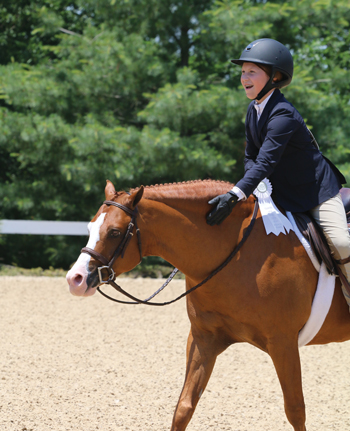
Do you enjoy showing? I always loved competing in horse shows. Whether I won a bunch of ribbons or came home empty-handed, each show was a unique adventure. After many years of showing, I became a hunter and equitation judge. Now I’ll share some advice so you can have more fun—and have a better chance at a blue ribbon—the next time you compete in a hunter show.


Judged on Horse Performance
In popular classes like hunters, hunter hack, hunters under saddle and English pleasure, the horse is the star. The judge is looking for a horse that performs safely and obediently. The winning horse should also have athletic ability. In classes with jumps (like hunters and hunter hack), the horse is expected to fold his legs tightly over the rails like a graceful acrobat.

Flat classes (like hunters under saddle and English pleasure) don’t include jumps, but the horse should still be safe and athletic. Natural balance and good movement are especially important in hunters under saddle. The judge wants to see a horse that moves along effortlessly with good energy and long, ground-covering strides.
Movement isn’t quite as important in English pleasure. Instead, comfortable gaits and a sweet attitude are rewarded. The winning English pleasure horse is
often the one the judge would like to ride home at the end of the day!
Judged on Rider Skill
The athletic ability and movement of the horse isn’t quite as important in equitation classes, where the rider is being judged. Horses of all breeds, colors and types can be wonderful blue-ribbon mounts as long as they can do the job.

Equitation classes are held on the flat and over jumps. In flat equitation classes, the rider’s position at all gaits is evaluated. If there are several outstanding riders in a class, the judge will require extra tests, like sitting the collected trot or posting without stirrups. To win a ribbon, riders will have to work; they can’t merely look pretty.
The same is true in an equitation over fences class. The winning rider must not only hold her position over the jumps, but also expertly guide her horse around the course. The best equitation riders compete in medal classes. The first-place winner gets an actual medal. At the end of the show season, all themedalists compete in the finals. It’s very prestigious.
Whichever classes you choose to enter, always remember that the judge wants you to be successful. Much of the time, the judge is silently cheering you on while jotting down notes on the scorecard. We know what it’s like to compete, and we’re just as excited about showing as you are!
Top 5 Hunter Show Judge’s TipsWant some extra advice? Every horse show judge has their own list of things they wish every young competitor knew. Here are five at the top of my list: 1. Know your diagonals and leads before you show. You’ll drop down (or out!) of the ribbons if you miss these in a class. 2. Enter classes according to your skill level. That way you’ll be competing against other riders with similar experience. For example, short stirrup hunters and green rider classes are designed for young equestrians just starting their show careers. 3. Give your horse plenty of time to settle down before your first class. Longe him if necessary. You could lose a ribbon if he’s frisky and decides to play during a class. 4. Don’t allow your horse to tailgate (follow too closely behind) other horses—especially his barn buddies—in flat classes. Instead, find your spot on the rail. Your horse will be more likely to obey your aids, and that will impress the judge. 5. You don’t need to spend a fortune on fancy tack and apparel, but you do need to show in what’s known as “proper English turnout.” Wear basic items that fit well. Leave inappropriate or illegal tack, as well as your colorful schooling accessories, at home. |
This article with hunter show secrets originally appeared in the July/August 2019 issue of Young Rider magazine. Click here to subscribe!


